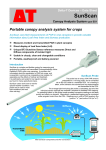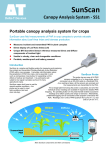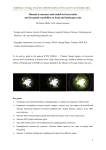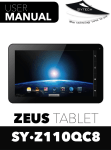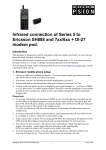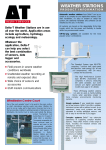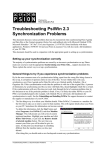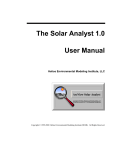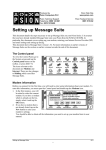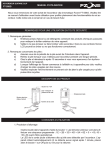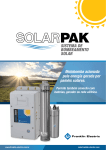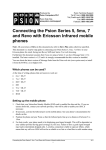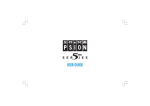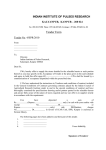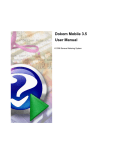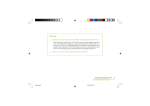Download SunScan
Transcript
Delta-T Devices Ltd SunScan Canopy Analysis System type SS1 • Measures incident and transmitted PAR in plant canopies • Direct display of Leaf Area Index (LAI) • Unique Sunshine Sensor type BF3, for measuring Direct and Diffuse components of incident light • Usable in all weather conditions • Portable, weatherproof and battery powered SunScan uses field measurements of PAR in crop canopies to provide valuable information about LAI and biomass production. Vast areas can be sampled quickly. Introduction The SunScan system offers convenient and flexible tools for measuring and analysing incident and transmitted Photosynthetically Active Radiation (PAR) in crop canopies. It provides vital information about the penetration of PAR into crops, and is essential in work such as comparative crop studies, for separating out the effects of cultivar and treatment. It is particularly well suited to low regular canopies (as found in many agricultural crops). SunScan users don't have to wait for special weather conditions - it can be used in most light conditions. SunScan Probe The probe has an array of 64 PAR sensors embedded in a 1m long probe, and is connected via an RS-232 cable to a PC or handheld Data Collection Terminal type DCT2. When a reading is taken, all sensors are scanned and the measurements transmitted to the Terminal or PC. The average light level along the probe is calculated, and all of the individual sensor readings are available if required for detailed PAR mapping. An operating button on the Probe handle enables successive readings to be taken quickly and simply on demand. Alternatively, unattended logging can be conducted under program control from the Terminal or PC. Readings are in units of PAR quantum flux ( µmol m-2 s-1 ). SunScan - Canopy Analysis System SunScan Probe and Data Collection Terminal, with SunShine Sensor mounted on tripod SunScan System Choices SunScan is modular and expandable. This means researchers can specify a system that suits their own performance requirements and budget System type Features and Advantages SunScan Recommended-Plus System type SS1-R3BF3 This is the complete package of SunScan items, including SunScan Probe, SunData Software, Data Collection Terminal, Sunshine Sensor type BF3, tripod and carrying case The Recommended-Plus System provides a powerful canopy analysis tool. It can calculate instant estimates of LAI, measure PAR interception using spot readings or with unattended logging and measure sunflecks. A major advantage for field use is that the BF3 Sunshine Sensor needs minimal adjustment during use (see opposite page). SunScan Standard System type SS1-STND2 The Standard System comprises The SunScan Probe, SunData Software and the Data Collection Terminal The Standard System is able to make the full range of SunScan measurements, including LAI. However, as the SunScan Probe has to be used as its own abovecanopy reference, it can only be used in steady light conditions: blue sky or evenly overcast. Entry System type SS1-ENTRY The Entry System includes the SunScan Probe and the SunData Software only The lowest cost version of SunScan. The Entry System runs on the user's portable PC instead of the Data Collection Terminal; it has all the functionality of the Standard System, but see "Use With a Portable PC" opposite, for comments on the use of PCs in the field. SunData software modelling An advanced model of light transmission through a uniform canopy has been developed and is used in the analysis software. This model builds on work by Campbell (1985), and Norman and Jarvis (1975), and takes account of the following factors: • Direct & Diffuse incident light • Solar zenith angle • Canopy Leaf Area Index • Canopy Leaf Angle Distribution • Leaf PAR absorption • Transmitted fraction Solar zenith angle is calculated from the actual time, latitude and longitude. Estimates of canopy Leaf Angle Distribution and Leaf Absorption are made by the user. All other variables necessary to calculate LAI are measured directly. Because the relative contributions of Direct and Diffuse incident light are physically measured at the same time as the transmitted PAR, readings can be made in a wider range of daylight conditions than has been possible with previous instruments. We advise against taking measurements when the sun is strong and near the horizon, when large errors may occur. The assumptions and calculations made in the SunData software are fully explained in the user manual, along with practical advice on how to use the system effectively. SunScan - Canopy Analysis System Sunshine Sensor type BF3, for above-canopy reference SunScan’s unique feature is an optional reference sensor, integrated into the design, to measure simultaneously the Direct and Diffuse light above the canopy. The Sunshine Sensor type BF3 provides these above-canopy reference measurements quickly and conveniently. Data analysis and storage Data Collection Terminal, type DCT2 The DCT2 is a robust, lightweight handheld computer (the Psion Workabout) which collects and analyses readings from the SunScan Probe. In the field, raw readings, and derived functions such as LAI, can be displayed, reviewed and stored by the SunData Software; groups of readings can be averaged if required. The Terminal's full alphanumeric keypad makes annotation easy. Readings are stored in the internal 2Mb internal memory which holds about 15000 readings (reduced with some data formats or if lengthy notes are entered). Optional 1Mb flashcards provide removable data storage or can hold copies of different Application set ups, making it easier to switch between different experiments. Collected data can be transferred to a PC. The optional PsiWin software provides convenient file transfer and data management for Windows based PCs. Unattended Logging (with DCT2) The SunData software can automatically take readings from the SunScan Probe, and averages, at user defined intervals, from 1 second to 24 hours. This might for example be used to obtain diurnal readings, at a particular location, of canopy light interception. The BF3 uses an array of photodiodes and a unique 1 shading pattern to calculate whether the sun is shining and to measure the Direct and Diffuse components of solar radiation. This completely avoids the need for troublesome shade ring adjustments required with conventional Diffuse light sensors. The special shading pattern of the dome is matched to the layout of photodiodes in such a way that at least one photodiode always sees an unobstructed solar disc and at least one is always in full shadow. The BF3 provides two cosine corrected analogue outputs, corresponding to the Diffuse and Total components and a digital output of sunshine presence. The outputs are compatible with most data loggers. The sensor uses no moving parts, requires no specific polar alignment or routine attention, and works at any latitude (levelling is the only adjustment required). Other Applications The BF3 can also be used with a data logger for long term monitoring of Direct and Diffuse light, and to record sunshine duration. For these purposes the output units can be preset to energy -2 (W.m ) or illuminance (klux), instead of PAR units. Further information is available on request. 1. Patent numbers EP 1012633, US 6417500. Delta-T can also supply HemiView, a system for obtaining and processing hemispherical images of plant canopies. If your research involves high, irregular canopies such as forests, please request a HemiView data sheet. Data Collection Terminal, type DCT2 Use with a Portable PC The SunData Software can be run on a portable PC, but in practice an extra person is usually required to hold the PC. In addition, most portables have a shorter battery life and are less rugged than the Data Collection Terminal. Use with a Data Logger The SunScan Probe can be connected directly to a data logger for use as a Linear Quantum Sensor. When powered by the logger, it outputs a voltage proportional to the average PAR incident on the probe. Cables for connecting the SunScan probe to a logger can be supplied. SunScan Specifications Ordering Information SunScan Probe type SS1 Active area Spectral response 1000 x 13 mm wide Sensor spacing 15.6 mm 400 - 700 nm (PAR) Measurement time 120 ms Maximum reading 2500 µmol.m .s -2 -2 -1 -1 Linearity 0.3 µmol.m .s better than 1% Accuracy ± 10% Analogue output 1 mV per µmol.m .s RS232, 9 pin female 'D' connector Resolution -2 Serial interface Environmental -1 Protected to IP65, 0 - 60° C working temp 1300(l) x 100(w) x 130(h) 4 x AA Alkaline cells (lifetime up to 1 year) Size (overall, mm) Power Sunshine Sensor type BF3 Output Sensitivity Total & Diffuse PAR Accuracy Temperature range -2 -1 1 mV per µmol.m .s (cosine corrected) Total ± 12%, & Diffuse ± 15%, PAR -2 -1 ± 10 µmol.m .s -20 to + 50°C with alkaline batteries -2 -1 Input Voltage Range 0 - 2500 µmol.m .s (Total & Diffuse) PAR (400-700 nm) 4 x 1.5V AA alkaline batteries, lifetime > 1 year typical 5 - 15V DC (powered from SunScan) Size & Weight 120 mm x 122 mm x 95 mm, 556g Range: PAR Spectral Response Power Data Collection Terminal type DCT2 Screen/ keypad Display options Power 10 lines x 40 characters, full alphanumeric a) LAI, b) PAR average c) ALL individual sensor readings IP54, 0% - 90% RH non-condensing, 20 to 60° C. Resists 1m drop onto concrete 2 x AA alkaline cells, or NiCd option Memory ~15,000 readings with internal memory Environmental SunScan systems All systems are based on main components listed below. SunScan Recommended-Plus System type SS1-R3-BF3 SunScan Probe, SunData Software, Data Collection Terminal, Sunshine Sensor type BF3 with cable type BFXL10, Tripod and Carrying Case SunScan Standard System type SS1-STD2 SunScan Probe, SunData Software and Data Collection Terminal SunScan Entry System type SS1-ENTRY SunScan Probe plus SunData Software (requires a portable PC for readout and data collection) Main components SunScan Probe type SS1 including alkaline batteries and user manual SunData Software type SDA1 Data Collection Terminal type DCT2 Psion Workabout, including alkaline batteries, comms cable and leather case. Sunshine Sensor type BF3 including user manual (NB requires cable type BFXL10 for use with SunScan Probe or type BFDL-05 for use with data logger, see below). Telescopic Tripod type SS-TD for mounting BF3 Carrying Case type SCC1 for SunScan Probe and accessories Optional Items NiCd battery pack type DCT-BAT for DCT2 Terminal Mains NiCd Charger type PSBC1 with docking unit for DCT2 (specify mains type: 230V AC 50Hz UK, or EURO, or 120V AC 60Hz) Removable flashcard type RFC2 for DCT2: spare 1Mb data storage card, holds typically an additional 8000 single readings PsiWin software type PSW2 PC-based software links Data Collection Terminal DCT2 to Windows PCs, providing convenient file and data transfer. PsiWin is strongly recommended for communications between the DCT2 and your PC. PsiWin can be purchased from Delta-T, or can be downloaded from the Psion website. Extension cables for BF3 with connectors: 10m cable type BFXL10, 25m cable type BFXL25, 50m cable type BFXL50. Logger cable type BFDL5 for BF3 Sunshine Sensor (3 channels). Cable terminates in bare wires. (For use with data logger, not with SunScan Probe) Logger cable type SSDL10 for SunScan probe enables SunScan to be used as a Linear Quantum Sensor when connected to a data logger (not for use with DCT2 or PC) For spares, recalibration and consumables please enquire Calibration The SunScan Probe (SS1) and Sunshine Sensor are calibrated under a standard light source against an accurate PAR quantum sensor traceable to national standards. The spectral and cosine responses of the sensors approximate to the ideal response (graphs available on request), but fall off at the extremes of the range. Under most normal daylight conditions errors due to the deviation are small, but it is possible, for example under artificial light, to find larger errors in the absolute values measured. However, because the SunShine Sensor and SS1 Probe are closely matched, and the calculations are based on ratios of incident and transmitted light, in practice this is not a problem. The SS1 Probe can be recalibrated by the user if necessary, using the BF3 SunShine Sensor. (Individual calibration values for each photodiode are stored in non-volatile memory within the Probe). SunScan Probe with Data Collection Terminal and Carrying Case Delta-T Devices Ltd 128 Low Road, Burwell, Cambridge, CB5 0EJ, UK Tel: +44 1638 742922 Fax: +44 1638 743155 E-mail: [email protected] Web: www.delta-t.co.uk SS1-DS-4 5 Sep 2002




